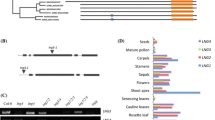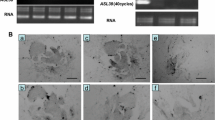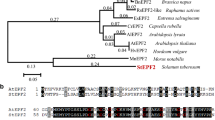Abstract
In seed plants, formation of the adaxial–abaxial polarity is of primary importance in leaf patterning. Since Arabidopsis thaliana (L.) Heynh. genes ASYMMETRIC LEAVES1 (AS1) and ASYMMETRIC LEAVES2 (AS2) are key regulators in specifying adaxial leaf identity, and ERECTA is involved in the AS1/AS2 pathway for regulating adaxial–abaxial polarity [L. Xu et al. (2003) Development 130:4097–4107], we studied the physiological functions of the ERECTA protein in plant development. We analyzed the effects of different environmental conditions on a special leaf structure in the as1 and as2 mutants. This structure, called the lotus-leaf, reflects a severe loss of adaxial–abaxial polarity in leaves. Higher concentrations of salt or other osmotic substance and lower temperature severely affected plant growth both in the wild type and the mutants, but did not affect lotus-leaf frequency in the as1 and as2 mutants. as1 and as2 mutants exhibited a very low lotus-leaf frequency at 22°C, a temperature that favors Arabidopsis growth. The lotus-leaf frequency rose significantly with an increase in growth temperature, and only in plants that are in the erecta mutation background. These results suggest that ERECTA function is required for reducing plant sensitivity to heat stress during adaxial–abaxial polarity formation in leaves.



Similar content being viewed by others
Abbreviations
- AS1, AS2 :
-
ASYMMETRIC LEAVES1, 2
- ER :
-
ERECTA
References
Bowman JL, Eshed Y, Baum SF (2002) Establishment of polarity in angiosperm lateral organs. Trends Genet 18:134–141
Byrne ME, Barley R, Curtis M, Arroyo JM, Dunham M, Hudson A, Martienssen RA (2000) Asymmetric leaves1 mediates leaf patterning and stem cell function in Arabidopsis. Nature 408:967–971
Chen C, Wang S, Huang H (2000) LEUNIG has multiple functions in gynoecium development in Arabidopsis. Genesis 26:42–54
Chen Q, Atkinson A, Otsuga D, Christensen T, Reynolds L, Drews GN (1999) The Arabidopsis FILAMENTOUS FLOWER gene is required for flower formation. Development 126:2715–2726
Douglas SJ, Chuck G, Dangler RE, Pelecanda L, Riggs CD (2002) KNAT1 and ERECTA regulate inflorescence architecture in Arabidopsis. Plant Cell 14:547–558
Eshed Y, Baum SF, Bowman JL (1999) Distinct mechanisms promote polarity establishment in carpels of Arabidopsis. Cell 99:199–209
Eshed Y, Baum SF, Perea LV, Bowman JL (2001) Establishment of polarity in lateral organs of plants. Curr Biol 11:1251–1260
Estelle MA, Somerville CR (1987) Auxin-resistant mutants of Arabidopsis thaliana with an altered morphology. Mol Gen Genet 206:200–206
Iwakawa H, Ueno Y, Semiarti E, Onouchi H, Kojima S, Tsukaya H, Hasebe M, Soma T, Ikezaki M, Machida C, Machida Y (2002) The ASYMMETRIC LEAVES2 gene of Arabidopsis thaliana, required for formation of a symmetric flat lamina, encodes a member of a novel family of proteins characterized by cysteine repeats and a leucine zipper. Plant Cell Physiol 43:467–478
Kerstetter RA, Bollman K, Taylor RA, Bomblies K, Poethlg RS (2001) KANADI regulates organ polarity in Arabidopsis. Nature 411:706–709
Li F, Flanagan CA, Zhao Y, Ma H, Huang H (1999) Assignment of 44 Ds insertions to the linkage map of Arabidopsis. Plant Mol Biol Rep 17:109–122
McConnell JR, Barton MK (1998) Leaf polarity and meristem formation in Arabidopsis. Development 125:2935–2942
McConnell JR, Emery J, Eshed Y, Bao N, Bowman J, Barton MK (2001) Role of PHABULOSA and PHAVOLUTA in determining radial patterning in shoots. Nature 411:709–713
Redei GP (1965) Non-mendelian megagametogenesis in Arabidopsis. Genetics 51:857–872
Sawa S, Ito T, Shimura Y, Okada K (1999a) FILAMENTOUS FLOWER controls the formation and development of Arabidopsis inflorescences and floral meristems. Plant Cell 11:69–86
Sawa S, Watanabe K, Goto K, Kanaya E, Morita EH, Okada K (1999b) FILAMENTOUS FLOWER, a meristem and organ identity gene of Arabidopsis, encodes a protein with a zinc finger and HMG-related domains. Genes Dev 13:1079–1088
Semiarti E, Ueno Y, Tsukaya H, Iwakawa H, Machida C, Machida Y (2001) The ASYMMETRIC LEAVES2 gene of Arabidopsis thaliana regulates formation of a symmetric lamina, establishment of venation and repression of meristem-related homeobox genes in leaves. Development 128:1771–1783
Siegfried KR, Eshed Y, Baum SF, Otsuga D, Drews GN, Bowman J (1999) Members of the YABBY gene family specify abaxial cell fate in Arabidopsis. Development 126:4117–4128
Sun Y, Zhang W, Li F, Guo Y, Liu T, Huang H (2000) Identification and genetic mapping of four novel genes that regulate leaf development in Arabidopsis. Cell Res 10:325–335
Sun Y, Zhou Q, Zhang W, Fu Y, Huang H (2002) ASYMMETRIC LEAVES1, an Arabidopsis gene that is involved in the control of cell differentiation in leaves. Planta 214:694–702
Sussex IM (1954) Experiments on the cause of dorsoventrality in leaves. Nature 174:351–352
Sussex IM (1955) Morphogenesis in Solanum tuberosum L: Experimental investigation of leaf dorsoventrality and orientation in the juvenile shoot. Phytomorphology 5:286–300
Talbert P, Adler HT, Parks DW, Comai L (1995) The REVOLUTA gene is necessary for apical meristem development and for limiting cell divisions in the leaves and stems of Arabidopsis thaliana. Development 121:2723–2735
Timmermans MCP, Hudson A, Becraft PW, Nelson T (1999) ROUGH SHEATH2: A Myb protein that represses knox homeobox genes in maize lateral organ primordia. Science 284:151–153
Torii KU, Mitsukawa N, Oosumi T, Matsuura Y, Yokoyama R, Whittier RF, Komeda Y (1996) The Arabidopsis ERECTA gene encodes a putative receptor protein kinase with extracellular leucine-rich repeats. Plant Cell 8:735–746
Tsiantis M, Schneeberger R, Golz JF, Freeling M, Langdale JA (1999) The maize rough sheath2 gene and leaf development programs in monocot and dicot plants. Science 284:154–156
Waites R, Hudson A (1995) phantastica: a gene required for dorsoventrality of leaves in Antirrhinum majus. Development 121:2143–2154
Waites R, Selvadurai HRN, Oliver IR, Hudson A (1998) The PHANTASTICA gene encodes a MYB transcription factor involved in growth and dorsoventrality of lateral organs in Antirrhinum. Cell 93:779–789
Xu Y, Sun Y, Liang W, Huang H (2002) The Arabidopsis AS2 gene encoding a predicted leucine-zipper protein is required for the leaf polarity formation. Acta Bot Sin 44:1194–1202
Xu L, Xu Y, Dong A, Sun Y, Pi L, Xu Y, Huang H (2003) Novel as1 and as2 defects in leaf adaxial–abaxial polarity reveal the requirement for ASYMMETRIC LEAVES1 and 2 and ERECTA functions in specifying leaf adaxial identity. Development 130:4097–4107
Yokoyama R, Takahashi T, Kato A, Torii KU, Komeda Y (1998) The Arabidopsis ERECTA gene is expressed in the shoot apical meristem and organ primordia. Plant J 15:301–310
Acknowledgement
The authors thank the Ohio State University Arabidopsis Stock Center and the Nottingham Arabidopsis Stock Center for providing as1-1, CS2340, as2-1, N230 and Lan seeds. This work was supported by grants from the Chinese Administration of Science and Technology (863), the Chinese National Scientific Foundation, and Shanghai Scientific Committee, to H.H.
Author information
Authors and Affiliations
Corresponding author
Rights and permissions
About this article
Cite this article
Qi, Y., Sun, Y., Xu, L. et al. ERECTA is required for protection against heat-stress in the AS1/AS2 pathway to regulate adaxial–abaxial leaf polarity in Arabidopsis . Planta 219, 270–276 (2004). https://doi.org/10.1007/s00425-004-1248-z
Received:
Accepted:
Published:
Issue Date:
DOI: https://doi.org/10.1007/s00425-004-1248-z




